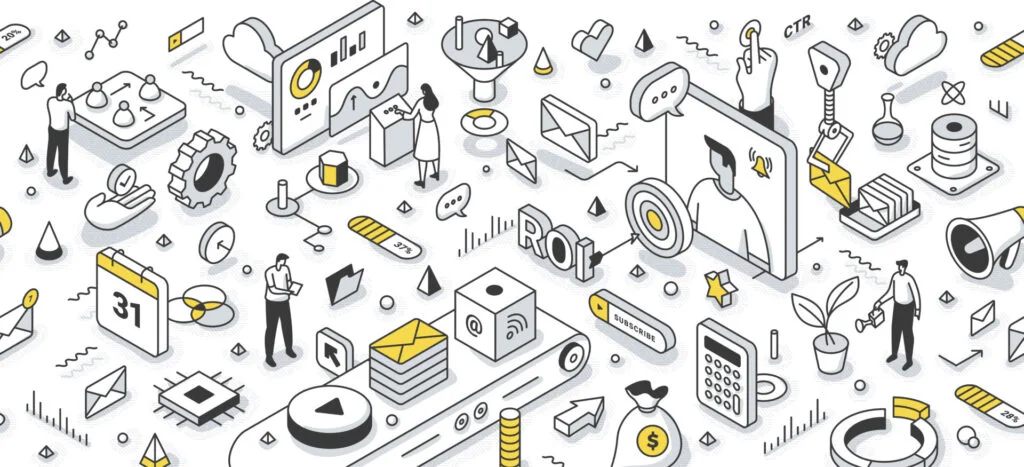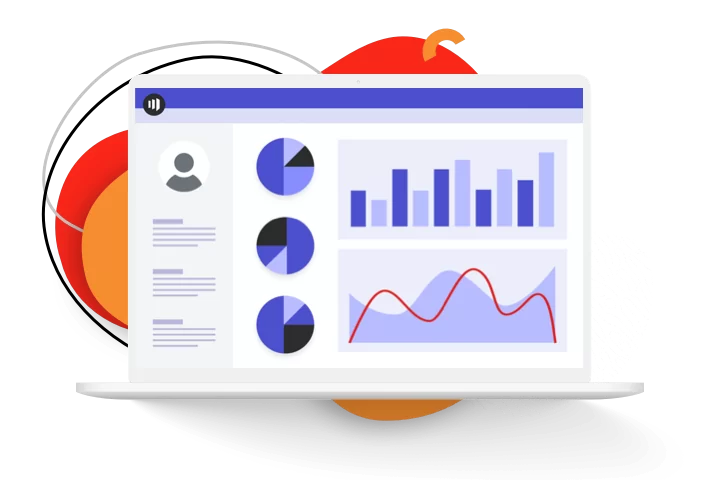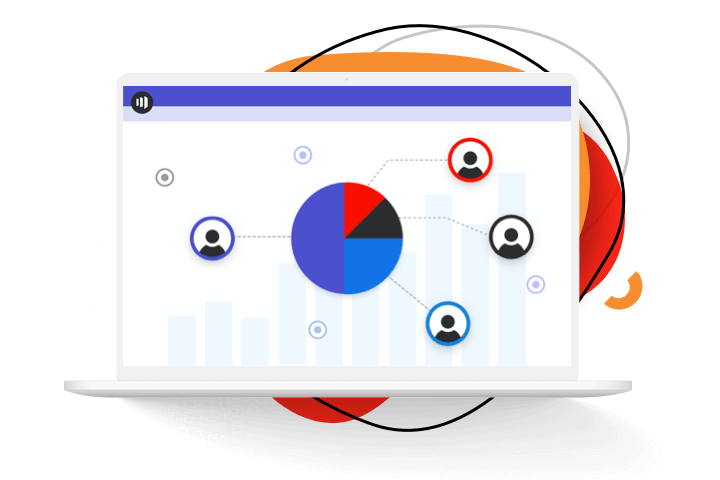Marketing automation is a software application that you install on your website that allows you to automatically collect data about the visitors to your site and how they interact with it, and to make custom offers or automatically send outbound marketing messages to specific segments of your visitors based on what they do on your site.

There are many examples of how marketing automation works, and there are also many tools you can use to create your own marketing automation plan. Here we will discuss all of these things in more detail.
A brief history of marketing automation
It’s not clear who coined the term marketing automation. It was probably one of those collective efforts that crops up in a field where lots of people are talking about similar things at roughly the same time. There were plenty of marketer-oriented platforms emerging on top of customer relationship management (CRM) systems back in 2006 and 2007—Marketo was founded in 2005 and HubSpot launched in 2006.
Marketers began to talk about using these technologies for marketing purposes. There were also new enterprise software companies cropping up that had names like marketing automation or used phrases like leveraging marketing automation technology in their sales materials.
What are different types of marketing automation?
There are two main ways to implement marketing automation into your business. 1. Outside-in and 2. Inside-out (also known as demand automation). Lets start with outside-in and move on to inside-out.
Outside-in entails capturing data from different channels and then using that data to create marketing campaigns based on a user’s behavior patterns or past interactions with your brand. This can be done through email, mobile messaging apps, desktop apps or even physical mailings based on information gathered from users preferences or previous behaviors toward your brand.
What is the future of marketing automation?
Marketing automation allows marketers to better understand their audience’s interests and interactions with brands. In other words, automation offers an organization more targeted information about customers that can make all of a marketer’s marketing efforts more efficient and effective.
So what will marketers do with that information? And how will they capitalize on it in 2022? To get answers to these questions and more, check out our latest infographic! We estimate a 19% increase from 2017 (which was $2.8 billion) to 2022 ($3.4 billion).
It’s important to note that much of marketing automation tools growth will come from increased spending by B2B organizations—as companies ramp up their digital customer experience programs over time we see less spend going toward traditional channels like print and direct mail…
What is a marketing automation tools?
The idea of marketing automation tools has been around for a while. For example, Google Alerts (2004) and email newsletters (2001) can be considered early forms of marketing automation. However, today’s definition is much broader than that.
The term marketing automation generally refers to software that allows you to automate digital marketing campaigns across various channels such as social media, online ads and landing pages. According to Marketo’s Digital Marketing Trends Report 2017 , marketers now spend almost 50% of their time on administrative tasks instead of doing their jobs—with 40% spent on emails alone! As a result of these numbers growing higher every year, it should come as no surprise that marketers are looking for faster ways to complete tasks like content generation and lead management.
What is B2C marketing automation?
The definition of marketing automation is actually dependent on who you ask. In fact, most experts agree that marketing automation isn’t really a tool or service in and of itself. Instead, marketing automation describes a process in which software uses specific triggers or actions to coordinate customer communications with business goals.
In other words, B2C (business-to-consumer) marketing automation refers to a set of tools and technologies which are used by businesses to automate certain elements of their direct market strategy through digital interactions and email campaigns. Marketers use B2C marketing automation services and tools to manage customer relationships online; such solutions often include interactive features for gathering information about individual customers as well as customized reports to help further promote sales efforts.
Marketo overview
Marketo makes CRM and marketing automation easier than ever. By offering multiple ways to view your leads and contacts—including graphical and chronological dashboards—you can follow every lead from point of interest all the way through to lead conversion. Its campaign builder has a drag-and-drop interface that enables you to quickly create personalized email campaigns for each of your leads.

Marketo’s analytics dashboard provides data on your company’s performance across numerous metrics (such as social media engagement or lead conversions) so you can stay ahead of trends and make sure your brand isn’t missing out on opportunities. You also have access to integrations with other industry tools, such as Salesforce or HubSpot, which makes implementation faster and more efficient than traditional web development methods.
Hubspot overview
B2C marketing automation enables businesses to deliver a superior customer experience while saving time and increasing revenues. With marketing automation software you can easily collect data on prospects, then use that information to communicate with each prospect individually to maximize your chances of turning them into paying customers.

A dynamic platform like Optimove allows businesses to organize their marketing activities through workflow management tools and predictive analytics. Since every business is different and has its own unique needs, there isn’t a one size fits all approach for B2C marketing automation.
As a result you will have to choose between different options such as single or multi-channel campaigns, email only or email/text/website tracking – whatever best suits your company’s needs and helps you achieve your goals faster.
Eloqua overview
There are a lot of things to consider when marketing automation. Luckily for you Eloqua takes care of most of that for you. All you have to do is set up your email based on who your target market is and what kind of communications you want to send out. Here’s a quick rundown on some features Eloqua offers so that you can be successful with your campaign. In-email voting – collecting email addresses while they decide if they want to sign up or not.
Pardot overview
Marketo, Eloqua and Hubspot are all leading marketing automation tools. They all have a wide range of features that make them easy to use but can be confusing for marketers trying to decide which tool is best for their business. The truth is that every business needs different things from a marketing automation tool and each tool has some unique capabilities that make them a strong fit for different companies.
We’ll look at each of these three popular tools in depth and give an overview of what you can expect if you choose one as your company’s primary marketing automation tool. Let’s start with Pardot.
Salesforce overview
Salesforce describes itself as the world’s #1 CRM platform. It’s a customer relationship management (CRM) system that was founded in 1999 by former Oracle VP Marc Benioff and Parker Harris. Salesforce has also expanded into other areas including service automation (Salesforce Service Cloud), e-commerce (Salesforce Commerce Cloud), marketing automation (Marketo), analytics and many more.

And at last count, its stock has hit an all-time high of $100 per share. That’s up from just over $7 when it went public in 2004. Oh, and one more thing: Salesforce is currently valued at about $50 billion – making it one of Silicon Valley’s most valuable private companies.
What does marketing automation do?
A lot of marketers like to explain marketing automation in terms of individual tools. That’s fine if you’re using a tool from one particular company, but those boundaries can be limiting.
Instead of focusing on individual tools or even departments within your organization that use automation technology (for example, e-mail and social media marketing), think about automation as a way to connect all of your channels in an automated fashion so that they work better together toward achieving a common goal.
Each piece helps with discovery and interaction—and each tool provides unique capabilities that help solve problems inherent in human nature. Here are some examples of how companies are using automation to achieve their goals. If your industry isn’t listed here, there are plenty of other ways to incorporate these ideas into your business.
How do I get started?
There are a number of marketing automation platforms to choose from. Depending on your budget and desired features, you’ll want to make sure you pick one that fits into your budget and timeline.
The best part about automation tools is that they work without requiring any additional staff time or effort—you just set them up and then let them go! Some tools will even monitor all of your digital channels for certain key words or phrases that you’ve programmed in (i.e., Take us back!) so you don’t have to keep up with all of your channels manually. Other helpful tools include ones that measure ROI based on each campaign. This can help you determine which campaigns are worth spending more money on and which aren’t as effective.
Additionally, some automated software allows users to create customized landing pages based off each specific campaign – meaning if someone takes an action through Facebook, you can have their specific email appear in front of them instead of sending everyone who clicks through a general page.
When do I use it?: If there is one type of tool that every small business should be using, it’s marketing automation software.
Advanced automation tips and tricks!
A/B testing has always been a part of marketing automation. It’s when you want to test two or more different versions of a page or email to see which performs better. That’s essentially how A/B testing works and it’s extremely useful for optimizing your marketing campaigns. However, there are other ways that marketers can use automation for more than just one test.
One way is to create an automated drip campaign based on someone’s actions on your website. For example, if someone visits a certain page on your site then they will receive an email with information about that product or service. Or if they don’t visit any pages then they will receive an email asking them what they were looking for. These types of automated emails are called drip campaigns because you can send out a series of emails over time (like dripping water) instead of sending out one big blast all at once.

Drip campaigns are great because people who visit your site might not be ready to buy right away but may be interested in buying something later down the road so these drip emails remind them about what you have available. Another thing that marketers can do with marketing automation is to set up rules so that specific things happen when certain events occur.
This is similar to setting up triggers in Google Analytics but instead of being based on traffic data, it’s based on user behavior within your app or website. For example, let’s say you have a special offer for new customers only and you want those customers to get their special offer as soon as possible after signing up. You could set up rules within your CRM software so that every time someone signs up they get an email saying thank you for signing up! Your special offer code XXXXXX expires today!
Conclusion
2021 was a major year for marketing automation. It started to be used by companies at all stages of growth, from startups to major enterprises. As software advancements continue and more enterprise features are added to products, it’s easy to predict that marketing automation will become even more widely adopted in 2022. As sales and marketing teams work increasingly closer together and sales continues their strong upward trend which began back in 2020 (also driven by marketing automation), we can expect there to be significant growth for marketing automation solutions.
Related post:




